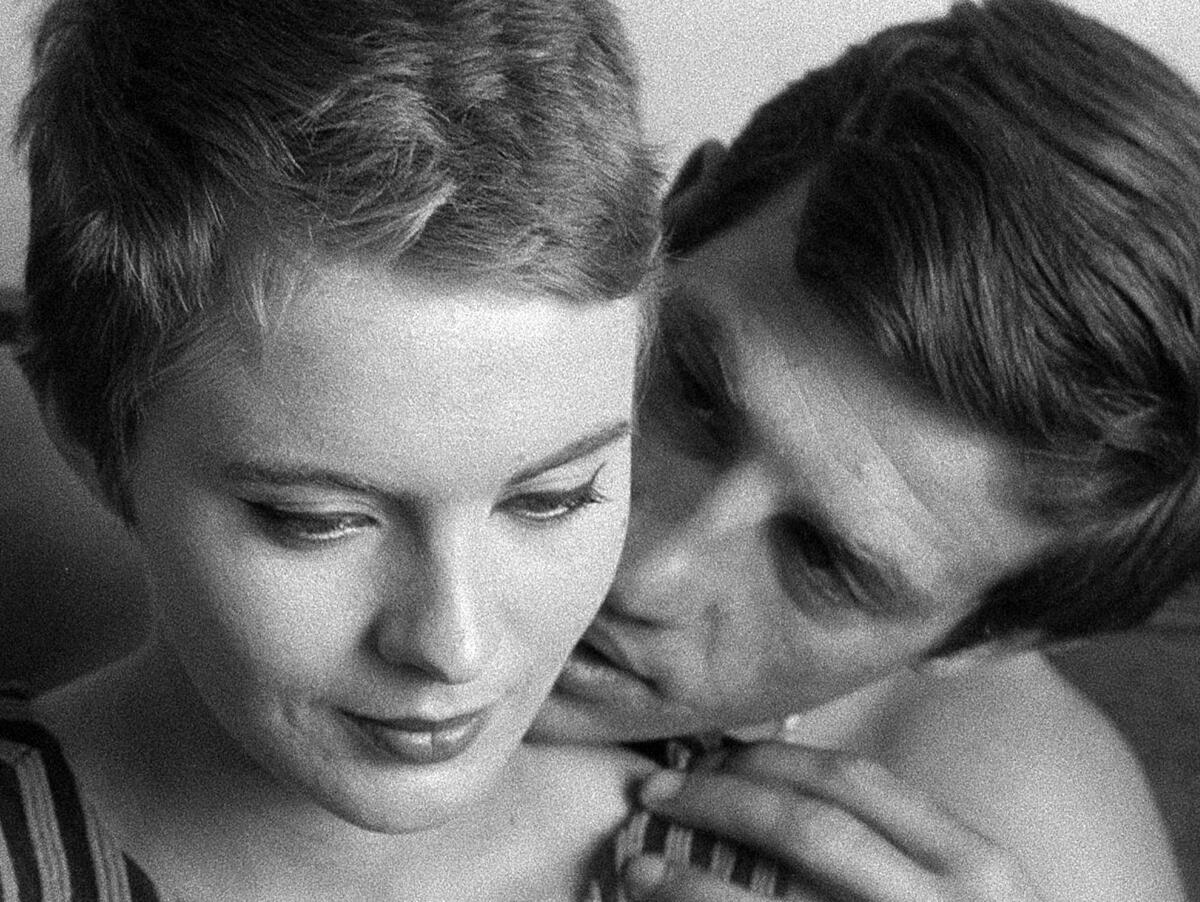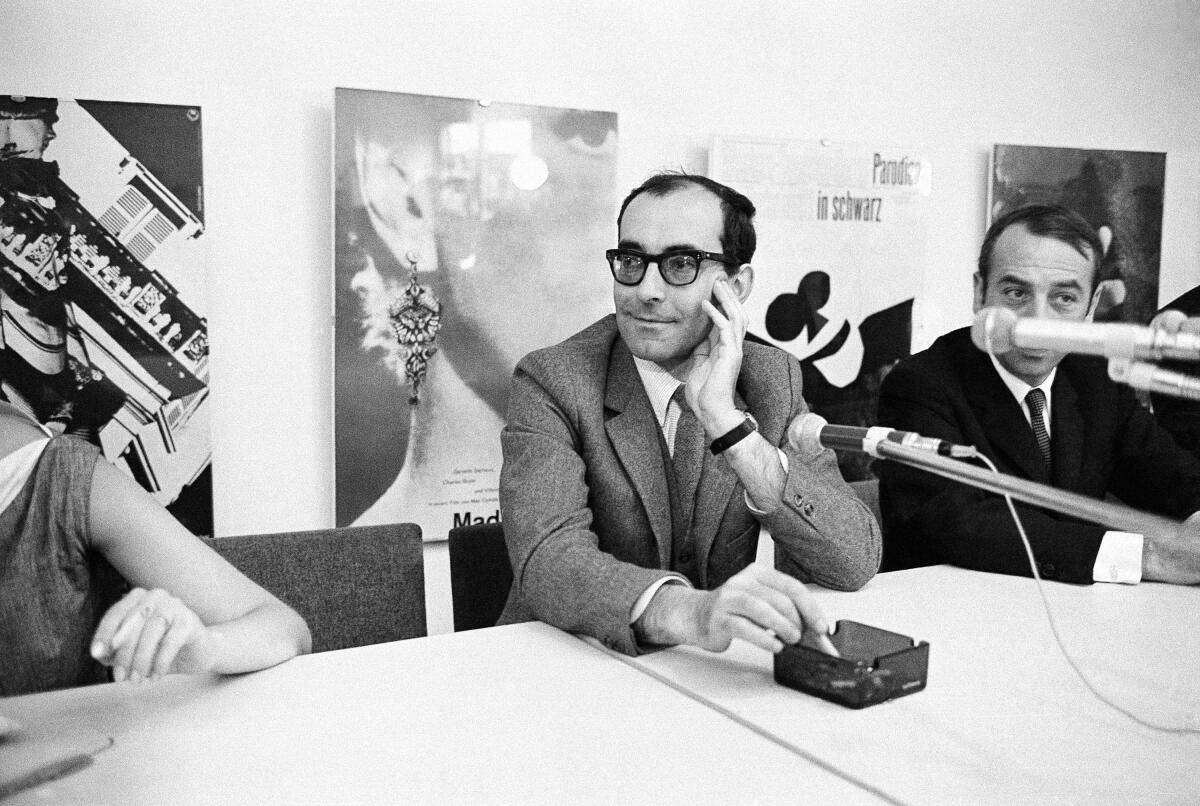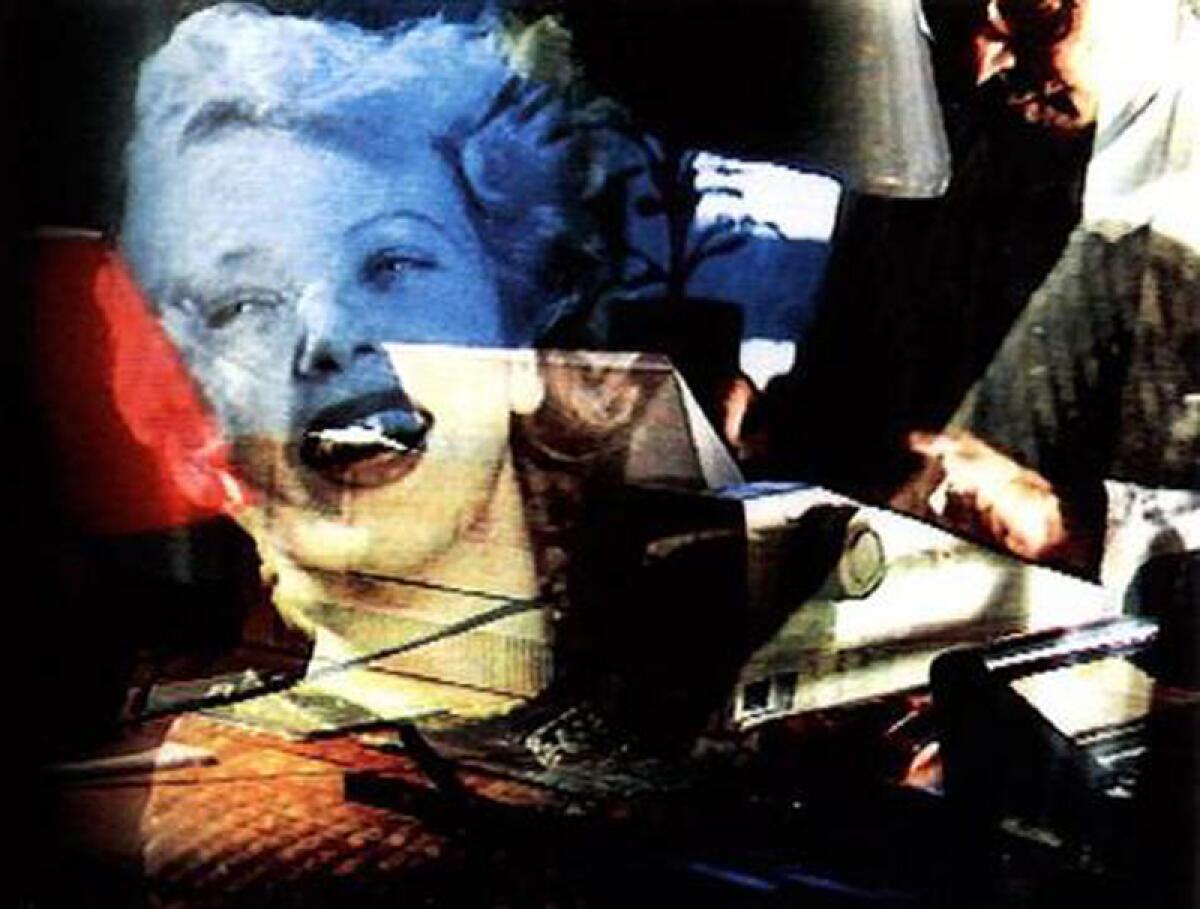My Jean-Luc Godard movie marathon: How I watched his collected works, in chronological order

- Share via
I am one of the Godard-obsessed.
There are many of us around, whose deep interest in the films of Jean-Luc Godard inspired such a love. Perhaps nothing illustrates my condition so much as when I once watched all of Godard’s movies, except for an elusive few, in chronological order, over a few months.
At the time of my project some 20 years ago, Godard had made about a hundred works (131 at the time of his death Tuesday, by IMDB’s tally), counting features, shorts, TV programs and ads, and other oddities. Video copies of most were rare or rarer, so finding them entailed a devoted campaign of internet searching.
The reward of those labors was an exquisite immersion in Godard’s oeuvre. It was a fascinating study of a filmmaking revolutionary whose relentless — even ruthless — drive for invention I found to be endlessly absorbing. If Akira Kurosawa was cinema’s Shakespeare, as Steven Spielberg has put it, then Godard was its Samuel Beckett.

My first encounter with Godard, the one that started it all, was “Breathless,” of course, at an L.A. theater in the mid-’80s.
I became disoriented early on, at the famous jump-cut scene at the end of the opening sequence, when Jean-Paul Belmondo’s character, Michel, shoots the cop. Michel, busy under the hood of the car he’d stolen, is confronted by a motorcycle cop on a country roadside. Michel reaches into the car for a gun. “Freeze!” says the cop. A closeup on a hand (whose?) squeezing the trigger of a pistol. Sound of a gunshot. A body falls. Wide-angle shot of Michel running across a field.
Cue jazzy music and cut to Michel in the back of a car arriving in Paris, where before long he greets Jean Seberg (Patricia) on the street selling copies of the New York Herald Tribune.
What just happened? I was still trying to figure that out as the narrative rushed ahead, and I never quite caught up. By the end I was lost. And astonished.
I stayed in my seat and watched it again.
Nothing in my movie-watching life (I was 20 or so) had prepared me for it. I had no idea movies could tell a story that way. After my second viewing that day, the narrative came into focus. And everything else — the jazzy soundtrack, the handheld shots in black and white, the movement, the shuffled montage and, of course, the ultracool Belmondo and adorable Seberg — drew me into a strange and wonderful new world. If what I’d been watching before were movies, what exactly was this?

The experience seeded what became my abiding interest in world cinema, Godard especially, and decades later my peculiar idea to watch in succession every movie he’d made.
My interest in doing so originated when Godard had embarked on a monumental TV miniseries called “Histoire(s) du Cinema.” He made it in eight parts, from 1989 to 1999. Upon completion, the series was collected into a movie of the same name, regarded by many to be his magnum opus. Drawing upon Godard’s many years of watching and making movies, it is a kaleidoscopic mosaic of sound and image, sprawling in its vision, invention, historical inquiry and length — 266 minutes in total. “Histoire(s)” is among my favorite movies, by Godard or anyone else.
But as the parts were being shown in France, they were screened rarely in the U.S., and English-subtitled video copies were rumored to exist, but I couldn’t find any. I had not seen any parts of “Histoire(s),” so I made a mission of finding them. In doing so, I became interested in finding other Godard rarities. From there sprouted my notion to watch all of Godard’s works, from his mid-1950s shorts through “Histoire(s).”
Some of Godard’s better-known works were finding their way onto DVD, but many more were strictly on VHS, often long out of production. And the rest were seemingly not available whatsoever.
I don’t remember how I discovered Robert the movie bootlegger — EBay or something — but he claimed to have quality VHS copies of many Godard titles for sale that I absolutely couldn’t find anywhere, including all eight parts of “Histoire(s).” Of course, I bought all eight. Image and sound were remarkably clean.
Robert, who lived in Colorado, vaguely described by email some sort of high-end duping machine he owned, but he otherwise never divulged his method of pirating Godard (and other) movies, nor how he acquired these seemingly nonexistent movies in the first place. The quality was not always good, but he always disclosed when I should expect a tape would be substandard.
In a six-decade career that included “Breathless,” “Week-end” and “Goodbye to Language,” the unaccountably great and inventive artist always managed to tick off all the right people.
Robert chased down my requests for titles he didn’t have on hand. I had to save up to buy his not inexpensive tapes, and then there was the ethical concern of bootlegs — though Godard himself liberally borrowed movie clips and shared his with others, which helped me rationalize. I bought dozens of his Godard movies over a few years: 32 Maxell VHS cassettes in all, each with a typewritten label noting one or more coveted titles.
Some of the finds were modest triumphs, out-of-print VHS titles that had eluded me despite years of hunting: “Numero Deux” and “Comment ça Va” of the mid-1970s, for example, Godard’s initial video experimentations that prefigured his visually stunning film-video hybrid movies of the 2000s and 2010s.
Some bigger finds included the documentaries “1 A.M.” and “1 P.M.,” resulting from Godard’s collaboration with D.A. Pennebaker; and a marvelous TV series featuring schoolchildren that Godard made with Anne-Marie Mieville, his longtime partner and collaborator, titled “France Tour Detour Deux Enfants.”
Bigger still were the Dziga Vertov Group films, the Marxist-themed projects Godard made with director Jean-Pierre Gorin and their filmmaking collective in the late ’60s and early ’70s. How the heck did Robert have the Vertov Group films? He had all four of the main ones: “Pravda,” “Wind From the East,” “Struggle in Italy” and “Vladimir and Rosa.” Not to mention others from the period often ascribed to the Vertov Group, including “See You at Mao” (a.k.a. “British Sounds”).
Among my favorites of Robert’s collection were his series of Godard “minis,” which he arranged in six volumes, each cassette featuring several rare (at the time) short films. These included the 1950s gems “Charlotte and Veronique, or All the Boys Are Called Patrick” and “Charlotte and Her Jules,” two pre-“Breathless” shorts, the latter featuring Belmondo; and “A Story of Water” from 1958, co-directed with Francois Truffaut. Some later rarities included “Meetin’ WA,” which paired Godard in conversation with Woody Allen; a documentary on the making of Godard’s “Every Man for Himself”; a Godard-directed TV ad for Girbaud jeans; and his mid-‘90s TV documentary “20x50 Years of French Cinema.” None of these I’d seen before my Robert connection.
But Robert didn’t have everything. Crucial holes in my collection remained, including Godard’s two earliest films. It would be years yet before I would see “Operation Beton,” his debut documentary of 1955, and “Une Femme Coquette,” his 1956 short adapted from the Maupassant story “The Sign.” For several other Godard titles I would likewise have to wait for future DVD or Blu-ray releases or the film-streaming abundance we enjoy today.
So when I finally screened my Godard retrospective, watching one or several at a sitting, it ran from “Charlotte and Veronique” (1957) through the complete “Histoire(s) du Cinema” (1999), plus one or two new ones Godard had made while I was hunting tapes from Robert. I had DVD copies of a fair number of the films, but most were on VHS, some of shady quality. I didn’t tally how many I watched in all, but I’d estimate my Godard festival comprised about 70 films.
The French New Wave auteur and iconoclast, who died Tuesday at 91, made more than 100 films. Here’s where to find six key titles, spanning his long career.
My methodical Godard exploration yielded an intimate understanding of the enormousness and trajectory of his body of work. I became aware not so much of the great films versus the lesser ones, nor of the sheer number necessarily, but of each as a segment in a larger whole, the vast, multi-decade movie that is “Jean-Luc Godard” — the mosaic construction of “Histoire(s)” exploded across the span of his filmmaking life.
So bold was Godard’s artistry that his movies still feel modern today, as if he were perpetually striving to dream up a new cinema, if not a new, more humane and habitable world. His films ranged from artistic masterworks to wandering experiments, with plenty of well-crafted, stylish, delightful ones in between. Most were richly endowed as both art and entertainment, and even among his misses, Godard was always well worth watching.
His work was as literary as any in movie history, but for all the book references and the recurring Godard essay coursing through much of it, ultimately his was a visual art. As the titles of his final two features — “Goodbye to Language” and “The Image Book” — suggest, for Godard the image was the thing.
With the Godard oeuvre now closed, pending posthumous releases, opportunities to view his films in the theater are few these days. But with many Blu-ray releases and YouTube and other streaming platforms, Godard’s collected works are more available to us in better quality than ever.
As I bid him farewell and reflect on my cinematic love, maybe it’s time to start over and watch them all again.
More to Read
Only good movies
Get the Indie Focus newsletter, Mark Olsen's weekly guide to the world of cinema.
You may occasionally receive promotional content from the Los Angeles Times.












